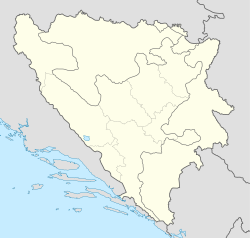world.wikisort.org - Bosnia_and_Herzegovina
Stari Grad (Serbian Cyrillic: Стари Град, pronounced [stâːriː grâːd]; lit. "Old Town") is a municipality of the city of Sarajevo, Bosnia and Herzegovina. It is the oldest and most historically significant part of Sarajevo. At its heart is the Baščaršija, the old town market sector where the city was founded by Ottoman general Isa-Beg Ishaković in the 15th century.
Stari Grad
Стари Град Old Town | |
|---|---|
Municipality | |
Clockwise from top: Stari Grad panorama, Latin Bridge, Gazi Husrev-beg Mosque, Vijećnica and the Sebilj. | |
 Stari Grad Location of Stari Grad, Sarajevo | |
| Coordinates: 43°52′N 18°26′E | |
| Country | |
| Government | |
| • Municipal mayor | Ibrahim Hadžibajrić (NES) |
| Area | |
| • Total | 51.4 km2 (19.8 sq mi) |
| Population (2013) | |
| • Total | 36,976 |
| • Density | 757/km2 (1,960/sq mi) |
| Time zone | UTC+1 (CET) |
| • Summer (DST) | UTC+2 (CEST) |
| Area code | +387 33 |
| Website | http://www.starigrad.ba |
Features
The municipality of Stari Grad is characterized by its many religious structures, and examples of unique Bosnian architecture. The eastern half of Stari Grad consists of the Ottoman influenced sectors of the city, while the western half showcases an architecture and culture that arrived with Austria-Hungary, symbolically representing the city as a meeting place between East and West.
The population of Stari Grad is 36,976, making it the least populous of Sarajevo's four municipalities. Its population density of 742.5 inhabitants per km² also ranks it last among the four. Stari Grad contains numerous hotels and tourist attractions including the Gazi Husrev-beg Mosque, Emperor's Mosque, the Sarajevo Cathedral and more.
Demographics
1971
126,598 total
- Bosniaks - 74,354 (58.73%)
- Serbs - 27,658 (21.84%)
- Croats - 12,903 (10.19%)
- Yugoslavs - 5,944 (4.69%)
- Others - 5,739 (4.55%)
1991
50,744 total
- Bosniaks - 39,410 (77.66%)
- Serbs - 5,150 (10.14%)
- Croats - 1,126 (2.21%)
- Yugoslavs - 3,374 (6.64%)
- Others - 1,684 (3.35%)
2013
36,976 total[1]
- Bosniaks - 32,794 (88.68%)
- Croats - 685 (1.85%)
- Serbs - 467 (1.26%)
- Others - 3,030 (8.19%)
Sites
Prior to 1914, the Austro-Hungarians who ruled Sarajevo wanted land in the Sarajevo Old Town district to build a city hall and library.[2] The land had a home on it and, despite offering the owner money, he refused and continued to refuse even when told that he had to move.[2] When the officials threatened him, he moved the house and rebuilt it, piece by piece, on the other side of the Miljacka river, as a way of spiting the officials.[2] The Sarajevo spite house operates today as a restaurant, called "Inat Kuća", which means "Spite House."[2]
Gallery
 No. 7 on this map of the Sarajevo Canton.
No. 7 on this map of the Sarajevo Canton.- The Emperor's Mosque.
- The Sarajevo cathedral
- Šeher-Ćehaja Bridge.
- The Cathedral of the Nativity of the Theotokos.
See also
References
- "Census of population, households and dwellings in Bosnia and Herzegovina, 2013: Final results" (PDF). Agency for Statistics of Bosnia and Herzegovina. June 2016. Retrieved 1 July 2016.
- Barnett, Tracy. (June 25, 2006) San Antonio Express-News Honey and blood. Section: Travel; Page 1L.
External links
Stari Grad,
Sarajevo.
На других языках
[de] Sarajevo-Stari Grad
Stari Grad („Altstadt“) ist eine Gemeinde (općina) mit knapp 37.000 Einwohnern im Stadtgebiet der bosnischen Hauptstadt Sarajevo. Während des Bosnienkrieges spaltete sich der serbisch dominierte Ostteil der Gemeinde ab und bildet heute die Gemeinde Istočni Stari Grad („Östliche Altstadt“) in der Republika Srpska.- [en] Stari Grad, Sarajevo
[ru] Стари-Град (община, Босния и Герцеговина)
Община Стари-Град (босн. и хорв. Opština Stari Grad, серб. Општина Стари-Град) — боснийская община, расположенная в Сараевском кантон Федерации Боснии и Герцеговины. Административным центром является Сараево.Другой контент может иметь иную лицензию. Перед использованием материалов сайта WikiSort.org внимательно изучите правила лицензирования конкретных элементов наполнения сайта.
WikiSort.org - проект по пересортировке и дополнению контента Википедии












